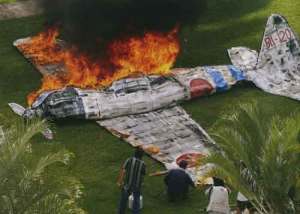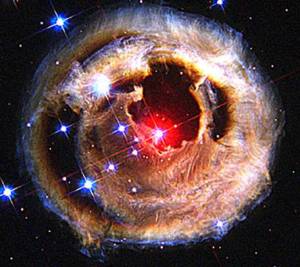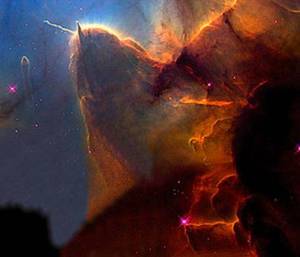Archive for August 2008
Some part of my journey 1/2
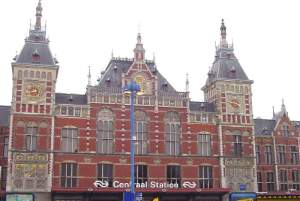
Amsterdam Central Station
As written in my previous blog, I am going to talk about some part of my journey today.
I got to know about Amnesty International when I was living in the Netherlands. The Netherlands is a small country with only 16 million people, but there were all kinds of NGOs and NPOs which contribute people’s well-being. It was also the country where people worked much less hours than Japan. At 6 pm, most full-time workers were gone home. Part-time workers were often permanent employees, meaning they had job security and were given flexibility in their working style. Retired, disabled, sick people, single moms or refugees I have met there did not have to worry about tomorrow’s bread or place to live.
Dutch are known as tightfisted, but when people get to know about adults, children or animals suffering somewhere, they do contribute to help. It could be by buying greeting cards of NGOs such as Amnesty, by donating money through very simple numbered giro order (often notified on TV), or by actually working voluntarily. I felt that the more people had time for themselves and yet their lives were secured, the better they could help others.
After coming back to Japan, I started working for a Dutch bank in Tokyo. I was so lucky that I could go home at 5:30 pm almost every day. In Japan, it is a miracle that you can go home so early. There were many people who regularly worked until 10 pm in the same bank. I started searching things I could do after work and found Amnesty International Japan. At that time, the office used to be in Waseda, one of students’ quarters in Tokyo. I got a list of volunteer groups and called one by one starting with Group 1. The person who answered my call was an American and he said to me, “our group is dying…” I called several other groups and decided to attend the Group 1’s meeting. There were only three attendees including myself, although the group had a lot more members. They were all busy with their own lives. I became a member of Group 1. Some complained about the people who did not attend the meeting, but I did not feel like blaming them. They were the rare people who kept contributing membership fee for years. Millions of others never even think of helping people whom they would never meet.
By cooperating with other groups outside of Japan, we contributed freeing prisoners in Vietnam and East Timor. Sometime after the prisoner in East Timor was released, the country became independent. I was very happy about some achievements that Amnesty had made. However, I became gradually restless. I had a reasonably secured life as a bank employee, and had time and energy to do humble voluntary work. But what about my own dream and growth? Every time when I was to move on to the next phase of my life, I was thinking to start studying art. It has been my lifetime dream and something I wanted to do all my life. I just could not start it at earlier stage of my life because of various reasons. But I also felt that I knew too little about the world I was living. I knew that once when I start studying art, I would not be interested in studying any other things. After thinking for some time, I decided to first study Economic Sociology in master course. This choice was strongly to do with what I saw and experienced in the Netherlands and at Amnesty in Japan. I will continue this story in my next blog.
Katsushige Nakahashi
On 14 August, at Artforum, a visiting Japanese artist Katsushige Nakahashi will give a lecture regarding his art projects. One of his project is called Zero Project featuring Japanese fighter planes during WWII. He and many volunteers fabricate a work with thousands of pictures and burn the finished work at the site of significance in the Pacific War. I will translate his lecture into English. The lecture will be held at Lecture Theater, School of Art, ANU from 1 pm.
14 August 1945 is the day that Japan decided to accept Potsdam Declaration and surrender unconditionally. Japanese Emperor Hirohito announced it through radio on the next day, so 15 August is usually considered to be the anniversary of the end of WWII in Japan.
63 years ago
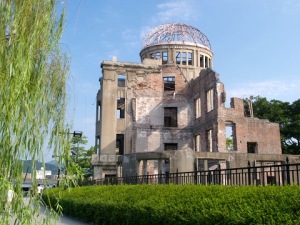
Hiroshima Peace Memorial
An atomic bomb was dropped in the middle of Hiroshima city exactly 63 years ago. Every year on 6 August, there is Peace Memorial Ceremony in Hiroshima, and on 9 August, in Nagasaki.
Approximately 140,000 of Hiroshima’s 350,000 population have died. Many have also suffered long-term sickness and disability. In Nagasaki, nearly 74,000 were killed and a similar number injured.
During the war, my grandmother was living in Osaka where massive attack by US bombers occurred. Before the attack, my mother evacuated to the hometown of my grandmother (my great grandmother was living there). My mother heard what had happened in Osaka and thought that her mother had died. The place she evacuated happened to be Nagasaki. My mother became one of atomic bomb victims. She survived two kinds of cancer, but luckily now she is in good shape and teaching exercise three times a week. My grandmother survived the attack, too, and lived until 92 years old.
What has done to Hiroshima and Nagasaki is a crime committed against innocent civilians like my family. The consequence of this terror is threatening whole human-kind now. The logic nowadays is that it is ok for certain early birds to have devices of mass destruction, and if certain late comers want to have the same, it is fine to kill and abuse such ‘terrorists’. What is going on in the world shows that not everyone is against this horrible logic.
If you have ever traveled the world and saw hundreds of people from various countries, you would notice that there is no distinctive border between races. If you go to certain part of Eurasia, you will see people who look somewhere between Caucasian and Mongoloid. In some part of Africa, people look like somewhere between Negroid and Caucasian. People just adapt themselves to climate, environment, community and society around them. Nothing is so different, even if race, religion or ideology is different. Everyone is born in the same way and everyone goes back to the same source where we all are originally from.
I think that it is important to be aware of foolishness to waste precious resource, fund and manpower to create and maintain armaments instead of spending them for true well-being of people. Artists should not be ignorant about it, either.
The following pictures are painted by Iri and Toshi Maruki. The hometown of Iri Maruki was Hiroshima and he heard about the atomic bomb in Tokyo. The first picture shows that people with burned-out skin were just like a lot of ghosts. The second picture shows that many bodies of mothers with surviving babys in their arms were found after the attack.
The glass mirror of Hubble Space Telescope
Glass is extremely difficult and mysterious material. It is hard to achieve the color you want, almost impossible to completely stabilize it after firing, difficult to polish it and so easy to break it. In fact, nobody really knows the best firing schedule for any kind of glass yet. Everyone fires and anneals glass just by experience and guess.
Here is the story of Hubble Space Telescope. According to this story, the most crucial and complex part of making this telescope was the mirror and optical systems. The glass mirror of Hubble was made in an enormous kiln. For firing glass, I use kilns with at most two square meters. The kiln used for the Hubble mirror would have been the size of a large room. As I wrote above, polishing glass is quite difficult, too. If polishing manually, it demands a lot of time, energy, accuracy and patience. Hubble mirror was polished by computer, but still it could not achieve the required accuracy.
After investing massive amount of effort and money, Hubble Space Telescope finally started sending images such as these. The following pictures are some of the top ten most amazing pictures taken by Hubble in last 16 years selected by astronomers.
“…they illustrate that our universe is not only deeply strange, but also almost impossibly beautiful.” Michael Hanlon/AH (Nov 25th, 2006)
Talking about our universe, there was a total solar eclipse on 1 August. Next year, it will be seen again on 22 July in Japan, too. I have seen one on 11 August 1999 at Lake Balaton in Hungary. “Diamond Ring” was incredibly beautiful and the darkness caused by the solar eclipse indeed let us imagine the end of the world.

